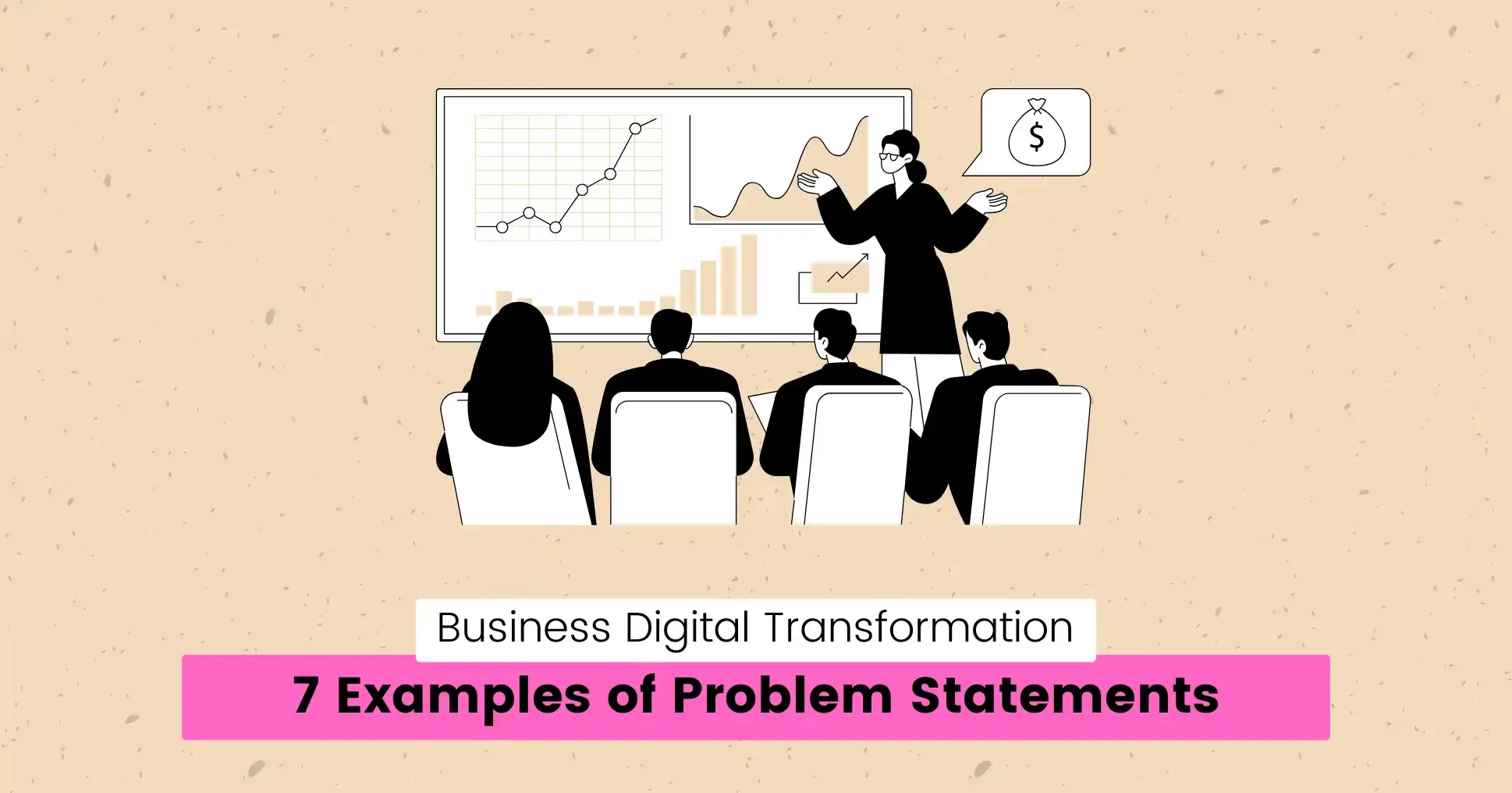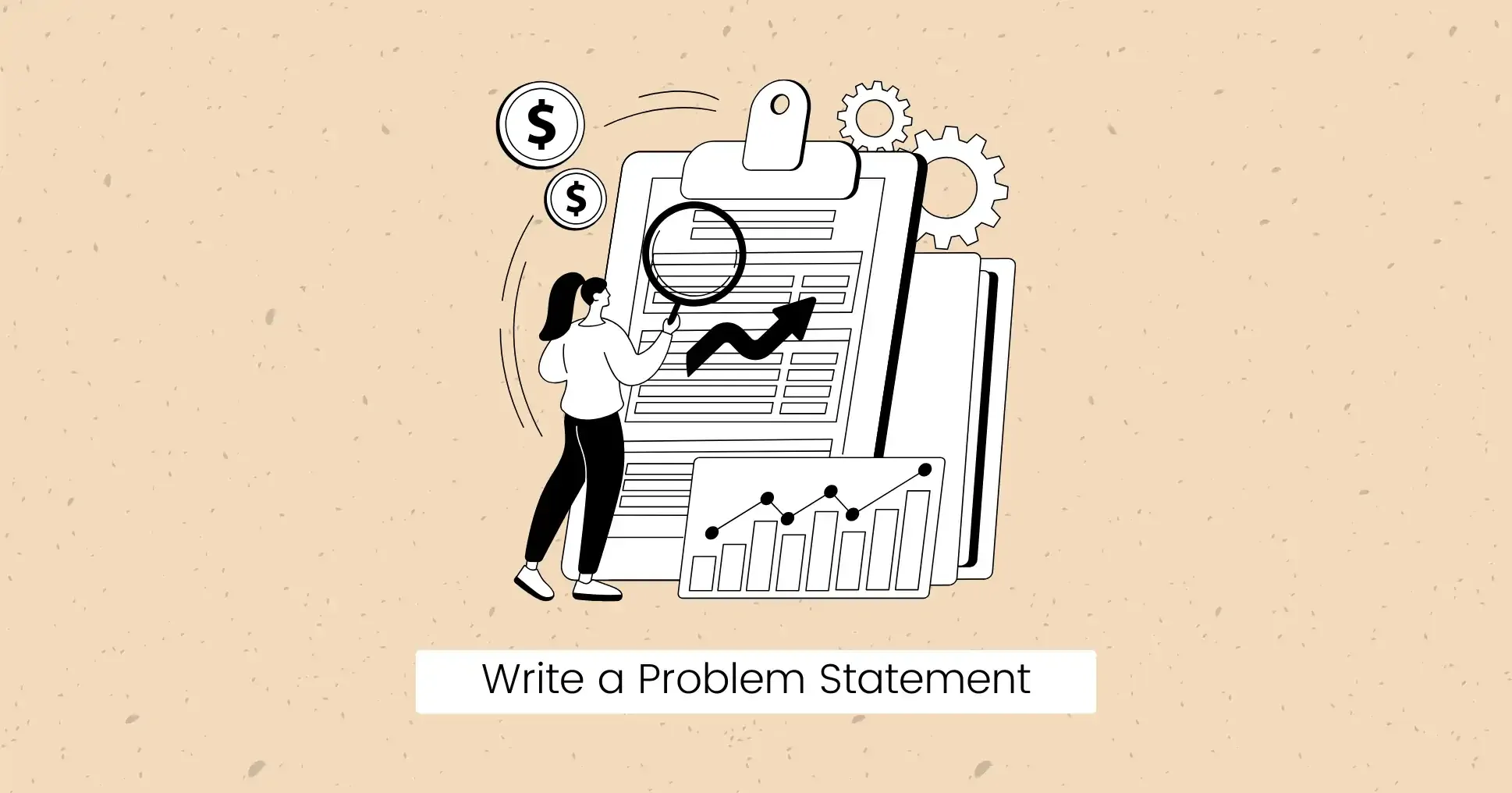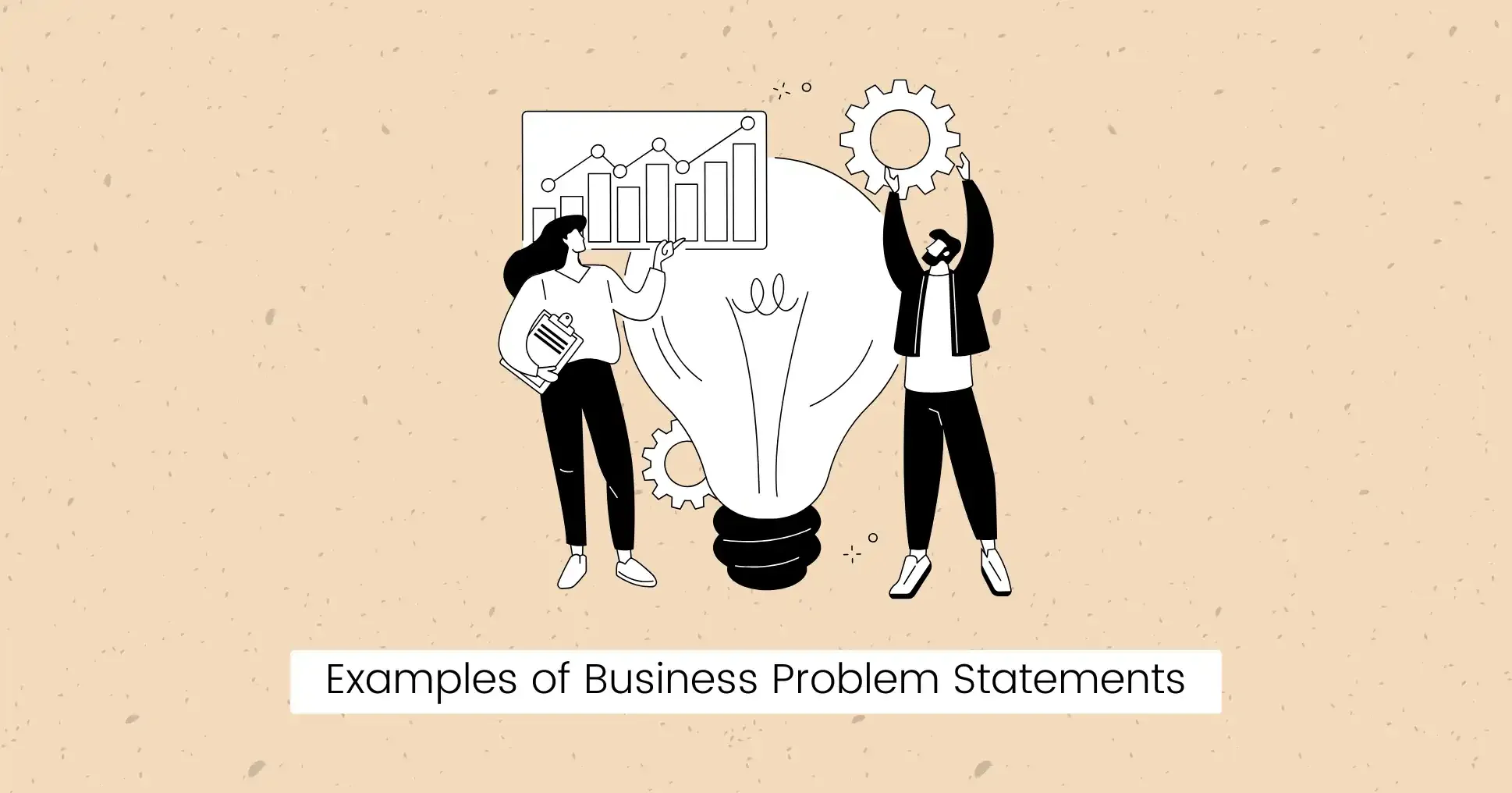7 Examples of Problem Statements for Business Digital Transformation (2025)

Digital transformation is the adoption of artificial intelligence (AI) and cloud technologies to improve business efficiency and sustainability.
However, many companies struggle with outdated systems and disconnected tools that slow down work and make it difficult to meet evolving customer needs.
Increasing expenses, manual processes, inefficient workflows, and poor customer experiences caused by lack of integration prevent businesses from reaching their full potential.
These problems don’t just disappear independently; they grow over time, and your team might feel stuck without a clear understanding of what needs to change.
The good news is that identifying the right problem statement is the first step to solving these challenges and moving your business forward.
But what is a problem statement, and how do you write one?
This guide will provide you with examples of problem statements to turn challenges into actionable plans.
Let’s get started.
What is A Problem Statement in Digital Transformation?
A problem statement is a short and concise description of a business’s specific challenge, including the problem’s root cause and impact.
A problem statement answers: What is the issue, why does it matter, and how will solving it create value?
A problem statement helps align digital solutions to meet business needs, such as fixing a broken checkout process on an online store or integrating legacy systems with modern APIs.
In some cases, it includes a proposed solution to resolve the issues and presents an opportunity for growth and innovation.
How to Write a Problem Statement

Digitalize Your Business!
Discover how automation can help you save time and resources. Let us advise you to gain a decisive competitive advantage.

A good problem statement includes the following key elements:
- Describe the issue objectively. Avoid vague terms like inefficiency or poor performance. Focus on one specific problem and measure the impact quantitatively. For example, manual order processing takes 12 hours each week, resulting in delays and errors.
- Explain the impact of ignoring the problem. Highlight pain points that stakeholders care about, such as revenue loss or reputation damage. Show how the problem affects operations, customers, and growth. For example, delays lead to customer complaints, 15% cart abandonment, and wasted staff time.
- Define the cause: Determine what causes the problem, such as outdated tools, manual processes, or integration limitations.
- Propose a measurable solution. Connect the solution to business performance metrics like employee productivity, conversion, and retention rates. For example, implementing an automated order management system will reduce processing time to 2 hours per week, cut errors by 95%, and improve customer satisfaction.
Why Problem Statements Lead to Successful Digital Transformation?
A problem statement offers several benefits that are essential for long-term business growth.
Such as:
- Focuses Resources: Writing problem statements eliminates guesswork and directs resources and efforts to the real issues.
- Aligns Stakeholders: A well-crafted problem statement keeps everyone, including developers, product managers, and end-users, on the same page and helps avoid misunderstanding.
- Measures ROI: Tracking metrics lets you know if a custom software solution delivers value and improves the return on investments.
- Reduces Risk: Problem statements help prioritize the right tools and potential solutions instead of wasting resources on unnecessary upgrades and fixes.
Examples of Business Problem Statements for Digital Transformation

Ready to Move Beyond Spreadsheets?
Let our experts help you implement the right tools and systems for your business performance tracking. Get in touch for a personalized solution that fits your needs.

Now that you know how to write an effective problem statement and the benefits it provides for your organization, let’s look at some problem statement examples to get you started.
Example 1: Limited Scalability of Legacy Systems
Problem:
A startup that grew from 50 to 500 users in a year is struggling with its outdated systems. These systems collapse frequently, especially during peak usage, and they cannot manage new integrations required for data analytics.
Impact:
- 30% downtime during peak hours, leading to delays in responses.
- Increased operational costs from constant system fixes.
Cause:
The legacy infrastructure was designed for small-scale operations and cannot handle high traffic or modern APIs.
Solution:
- Migrating to a cloud-based system resolves these issues.
- A custom-built platform with microservices architecture enables each component to run separately, allowing for advanced scaling.
- Real-time monitoring tools proactively address system constraints.
Example 2: Inconsistent Customer Data in Retail Banking
Problem:
With no centralized management, a local bank’s client information is distributed over three systems (CRM, loan management, and a mobile app).
Advisors spend 20 minutes per client call verifying data, which leads to mistakes in providing accurate information.
Impact:
- 23% longer call times compared to industry standards.
- 14% of customers churn annually due to mismatched communication.
- Outdated customer records resulted in $250,000 lost in compliance fines each year.
Cause:
Systems were implemented slowly over a ten-year period without a data governance approach, resulting in duplicate entries.
Solution:
A centralized customer data platform (CDP) featuring:
- Automated data cleansing to merge or delete duplicates.
- Real-time sync between branch, mobile, and backend systems.
- Role-based digital dashboards for advisors to access client profiles instantly.
Example 3: Slow Response Times Impacting Customer Retention Rate
Problem:
A SaaS company with 5,000 customers has slow response times in customer support, averaging 72 hours per ticket. This has resulted in an 8% annual turnover rate, costing $1.2 million in recurring revenue.
Impact:
- High churn rate due to poor customer experience.
- Damage to brand reputation, reducing new customer acquisitions.
- Support team unable to keep up with growing demand.
Cause:
The current ticketing system is generic and lacks automation for routing, prioritization, and updates.
Solution:
- A custom support system designed according to the company’s needs can significantly improve response times.
- Automated ticket routing can help prioritize critical issues.
- Self-service portals, such as searchable knowledge bases, minimize ticket volume.
- Integration with the company’s CRM system provides accurate client details, enabling faster resolutions.
Example 4: Manual Compliance Reporting for Healthcare SaaS
Problem:
A healthcare SaaS provider conducts compliance audits using 12 different checklists and handwritten PDF reports. Each audit requires 8 people to work 50+ hours to compile data from seven systems, including user logs, access controls, and encryption records.
Impact:
- 90% of time spent on repetitive data entry.
- $45,000 per year lost in penalties for missed deadlines.
- Unable to scale due to compliance issues.
Cause:
There is no automation for matching regulatory requirements to activity logs or security protocols.
Solution:
A customized compliance automation engine can solve this problem with features like:
- Rules-based workflows to automatically generate audit trails from system metadata.
- AI audit assistants to find gaps in real-time (e.g., expired user access).
Example 5: Poor Mobile Experience for Hospitality Brand
Problem:
A hotel chain’s mobile site took 5 seconds to load, did not offer booking customization, and was not localized for global travelers.
Impact:
- 55% bounce rate on mobile devices.
- 80% of abandoned bookings occurred on the mobile site.
- Negative reviews cited outdated mobile user experience.
Cause:
The mobile website was not updated for more than a year, resulting in poor performance.
Solution:
A custom mobile app with features like:
- Lazy loading and CDN caching to cut load times.
- Dynamic modules for personalized add-ons during checkout.
- Geolocation-based UI/UX (currency, language, local offers).
Example 6: Inventory Issues Due to Inaccurate Demand Prediction
Problem:
A medium-sized business frequently overstocks across its product lines.
Over the last year, this has led to $500,000 in unsold inventory and missed income opportunities due to popular items being unavailable.
Impact:
- Increased costs and lost revenue due to excess inventory.
- Lost potential customers to competitors.
Cause:
The company relies on manual data collection and spreadsheets for inventory management.
Solution:
- A custom forecasting solution can help track business performance without spreadsheets .
- The system can make accurate inventory predictions by integrating sales data, customer behavior analytics, and market trends.
- Automated reordering and real-time stock tracking can reduce manual work and enhance customer satisfaction.
Example 7: Poor Team Collaboration Due to Separate Tools
Problem:
A consulting firm with 200 employees utilizes separate tools for communication, file sharing, and project management. One team uses email, while another relies on messaging apps, creating confusion and delays in cross-departmental projects.
Impact:
- An average project delay of 2 weeks due to miscommunication.
- Missed deadlines, leading to a 15% decline in customer loyalty.
- Employee frustration and burnout due to unclear processes.
Cause:
There is no centralized communication and task management platform where team members can collaborate, share files, and track project progress.
Solution:
- Developing a digital platform that combines messaging, file sharing, and project management into a single solution can improve team collaboration.
- Features like task prioritization, real-time alerts, and project timelines contribute to better transparency and accountability.
Final Words
Problem statements are a must for successful digital transformation.
A clear understanding of the problem statement ensures custom development solves actual problems that are limiting growth.
Outsource custom software development to experts and implement the best solutions to meet your unique business needs.
Strengthen Your Team with Experts
Looking for specialized skills for your software project? Our experienced team integrates seamlessly and moves your project forward. Contact us for customized solutions!

FAQs
How long should a problem statement be?
A problem statement should be concise, typically between 150 and 300 words. It should not be overly descriptive but give the reader enough information to grasp the issue properly.
Is a problem statement different from an incident report?
A problem statement defines a business issue that needs to be resolved, while an incident report documents specific events or disruptions, including their causes and resolution.